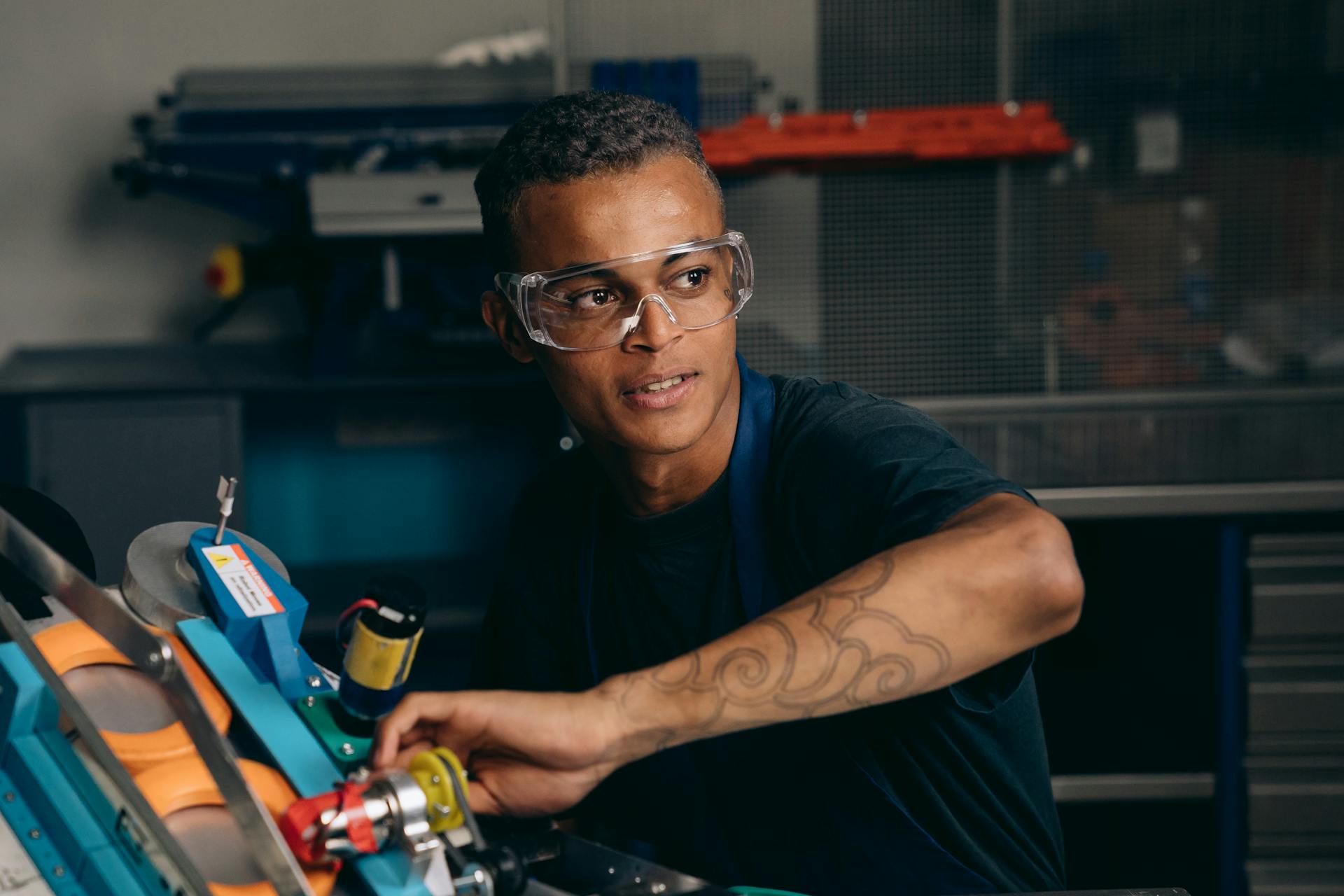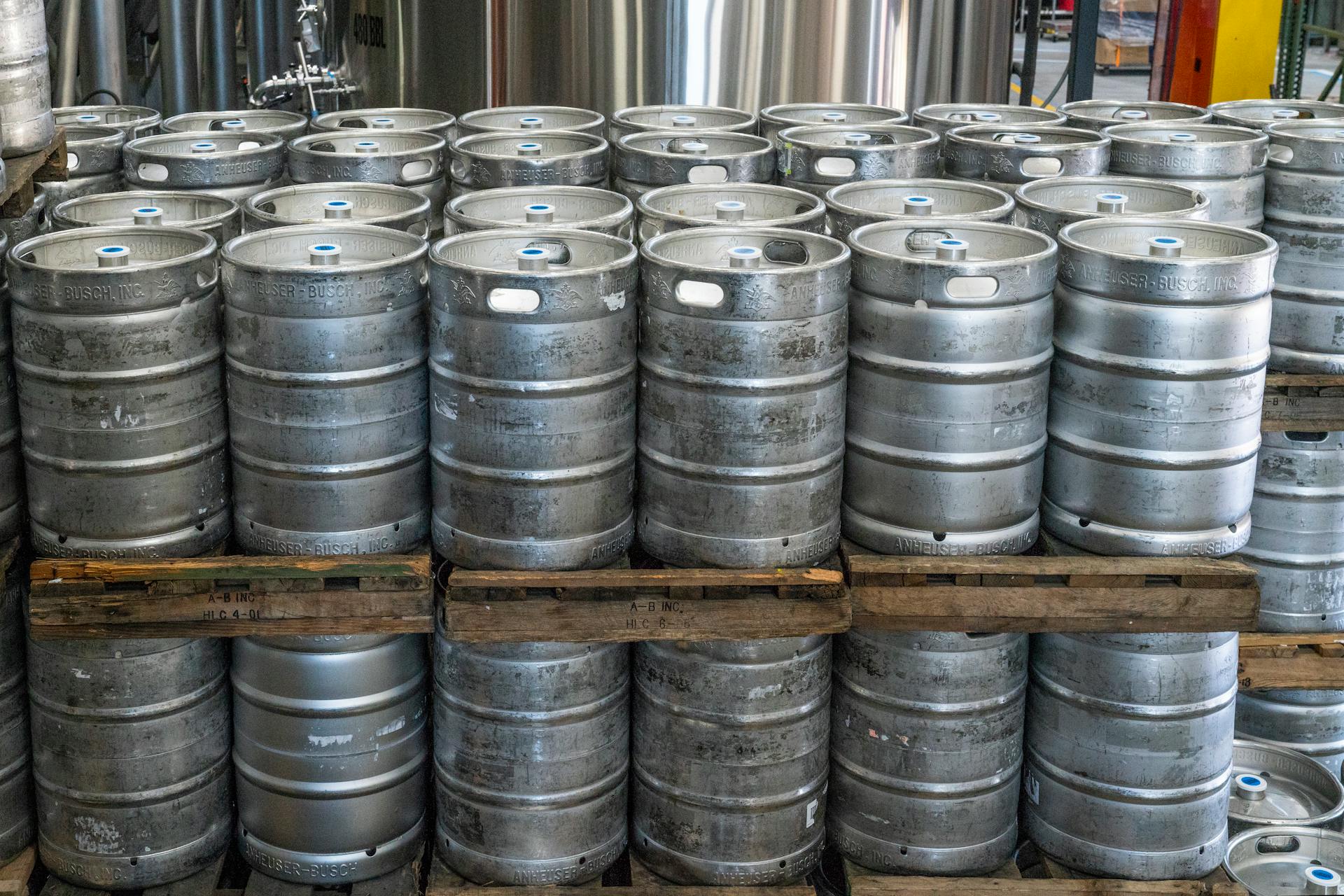
Intermediate bulk containers (IBCs) come in various types, each with its unique features and advantages.
The most common types of IBCs are plastic, metal, and fiber.
Plastic IBCs are made from durable and versatile materials, making them suitable for storing a wide range of products.
Metal IBCs, on the other hand, are made from stainless steel or aluminum and are often used for storing hazardous materials or products that require a high level of sanitation.
Fiber IBCs are made from natural or synthetic fibers and are often used for storing dry goods or powders.
IBCs can be used for storing a variety of products, from food and beverages to chemicals and pharmaceuticals.
Their versatility makes them a popular choice for many industries, including manufacturing, logistics, and distribution.
Types of IBCs
Intermediate bulk containers (IBCs) come in a variety of types to suit different needs.
The construction of IBCs can be classified into several types, including U-Panel, Circular/Tubular, Baffle, Four side panel, and Round construction.
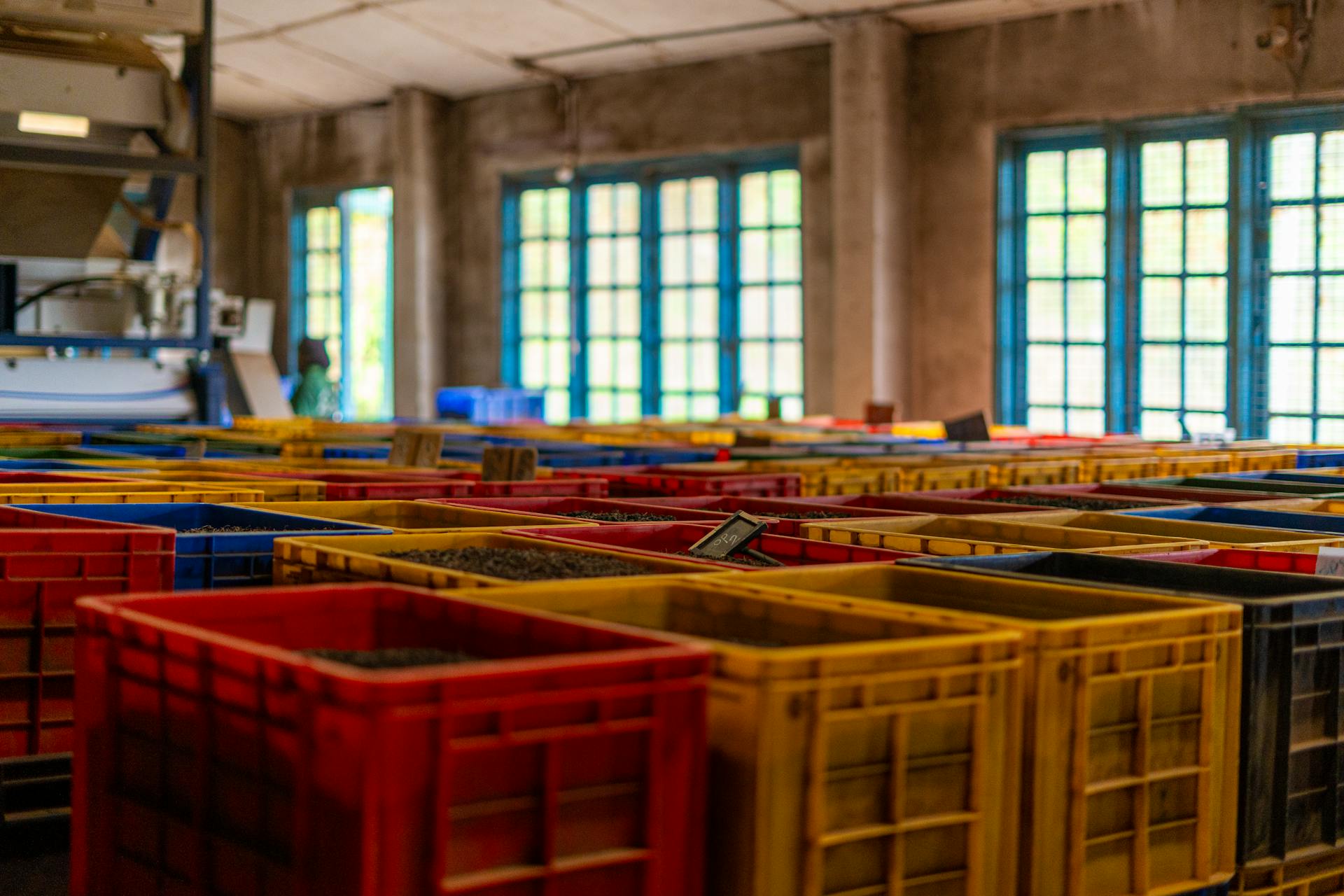
Each type of IBC construction has its own unique characteristics, but they all serve the same purpose: to safely transport goods.
For lifting and moving IBCs, there are several options available, including Cross corner lifting loops, Corner lifting loops, Four loops, Two loops, and Sling loops.
IBCs are also classified based on their electrostatic safety features, with Type - A, Type - B, Type - C, and Type - D being the main categories.
Type - A IBCs do not have any special electrostatic safety features, while Type - B IBCs have a breakdown voltage of 4 kilovolts or less, preventing the generation of propagating brush discharges.
Type - C IBCs are conductive and designed to control electrostatic charges by grounding, using conductive threads or tape in the fabric.
Type - D IBCs have anti-static or static dissipative properties without the need for grounding.
Here's a summary of the different types of IBCs:
IBCs are used to transport a wide range of goods, including chemicals, fertilizers, fiberglass, food products, grains, and more.
In fact, the article mentions that IBCs are used in various industries such as mining, construction, and pharmaceuticals to transport products like shotcrete, sand, gravel, and pharmaceuticals.
Design and Features
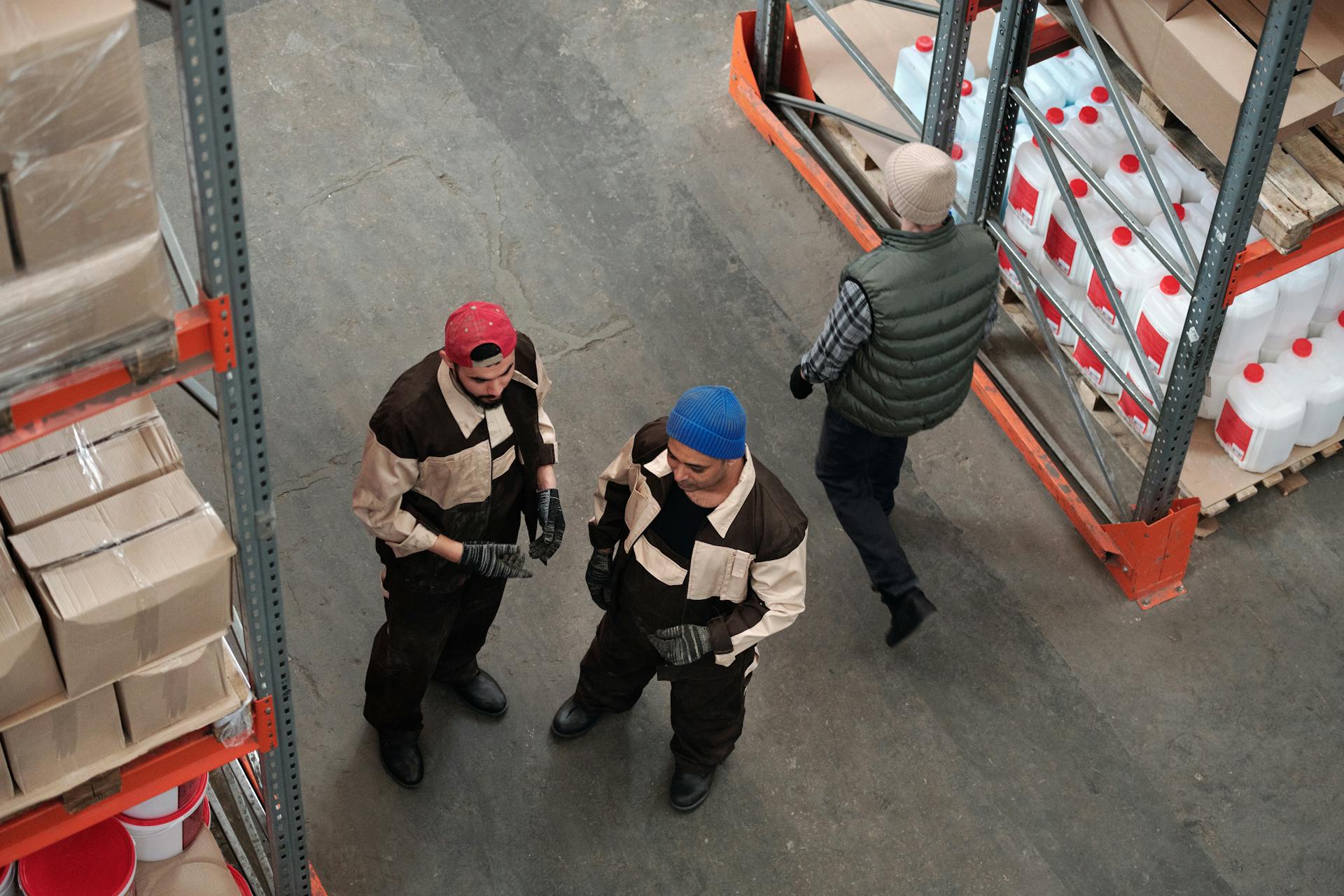
Intermediate bulk containers, or IBCs, are designed with efficiency in mind. They're cube-shaped, which makes them easy to stack and store.
The standard dimensions of a rigid IBC's pallet base are 1,200 mm × 1,000 mm or 48 in × 42 in (1,219 mm × 1,067 mm). This allows for universal maneuverability using forklift/pallet jack channels.
Most IBCs have a built-in tap at the base, making it easy to attach hoses or pour contents into smaller containers. This feature is a game-changer for businesses that need to transfer liquids efficiently.
The most common IBC size is 1000L, which fits on a single pallet, just like four 200L drums. This means you can store 12% more product in the same space as a drum storage setup.
On a similar theme: Ups Store St Augustine Beach
Advantages and Benefits
Intermediate bulk containers (IBCs) are a game-changer for businesses looking to streamline their logistics and packaging processes. They offer a multitude of advantages and benefits that can help you save time, money, and resources.
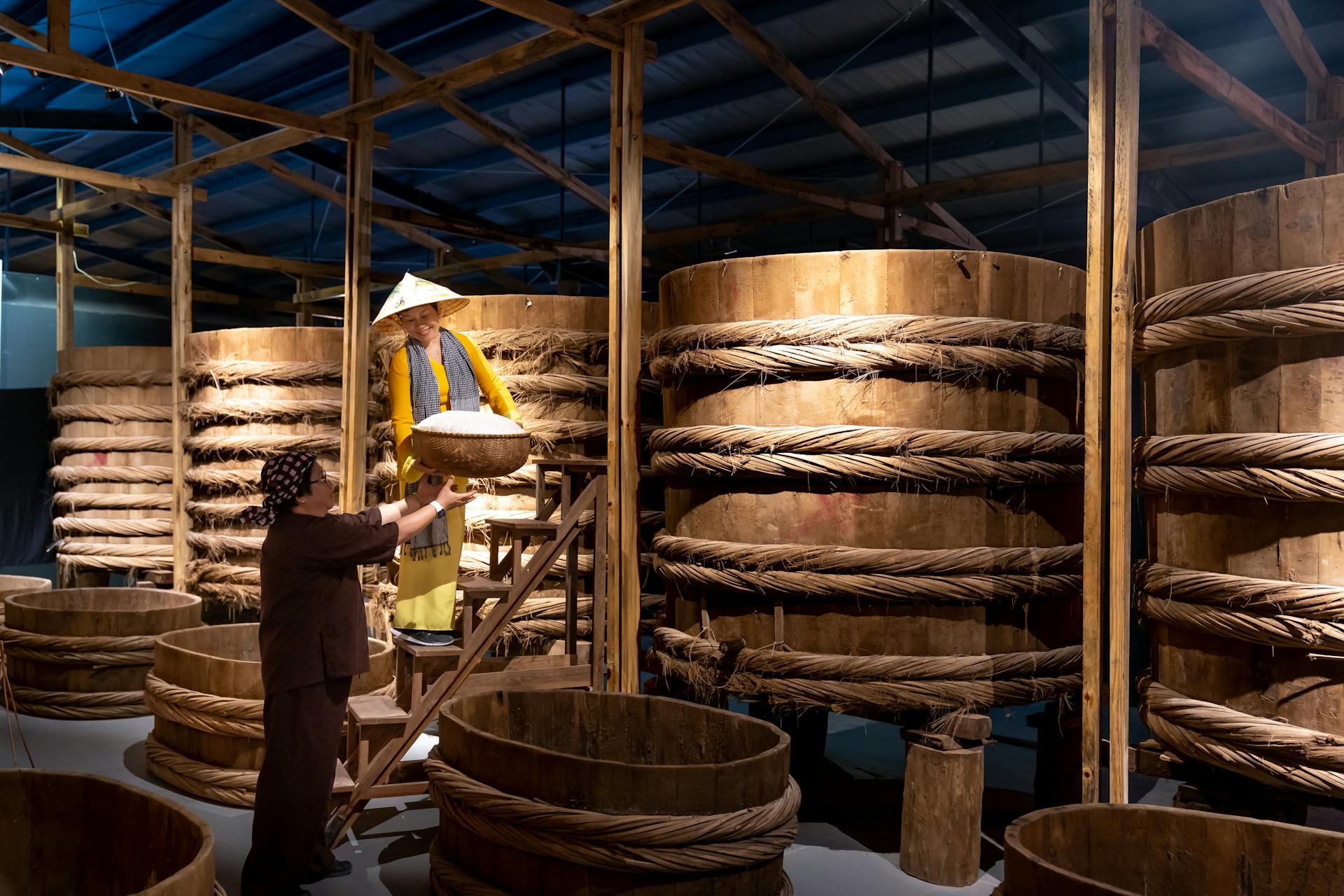
IBCs are cubic in form, allowing them to transport more material in the same footprint compared to cylindrical-shaped containers. This makes them ideal for shipping large quantities of products.
One of the key benefits of IBCs is their cost-effectiveness. They are typically more affordable than smaller containers, especially when shipping voluminous amounts of product. The more tonnage you move, the more an IBC saves on the bottom line.
IBCs can be easily filled and discharged with a variety of systems, including plastic liners. This makes them a versatile option for businesses with different packaging needs.
Here are some of the key advantages and benefits of IBCs:
- Increased logistic and handling timelines, efficiencies, and capacity through single container filling, moving, loading, transit, and dispensing.
- Potential long-term assets given the durability of IBC construction materials.
- Provides a reliable and consistent way to handle or store materials.
- Cost-effective and reusable, making them a sustainable option for businesses.
- Easy to load and unload, reducing handling times and increasing efficiencies in your supply chain.
IBCs can also be stacked for optimal use of space during shipping and storage, making them a space-efficient option for businesses. Their cube-shaped design also allows for easy shipping, conveying, and transport due to its common pallet size in North America and other countries.
Uses and Applications
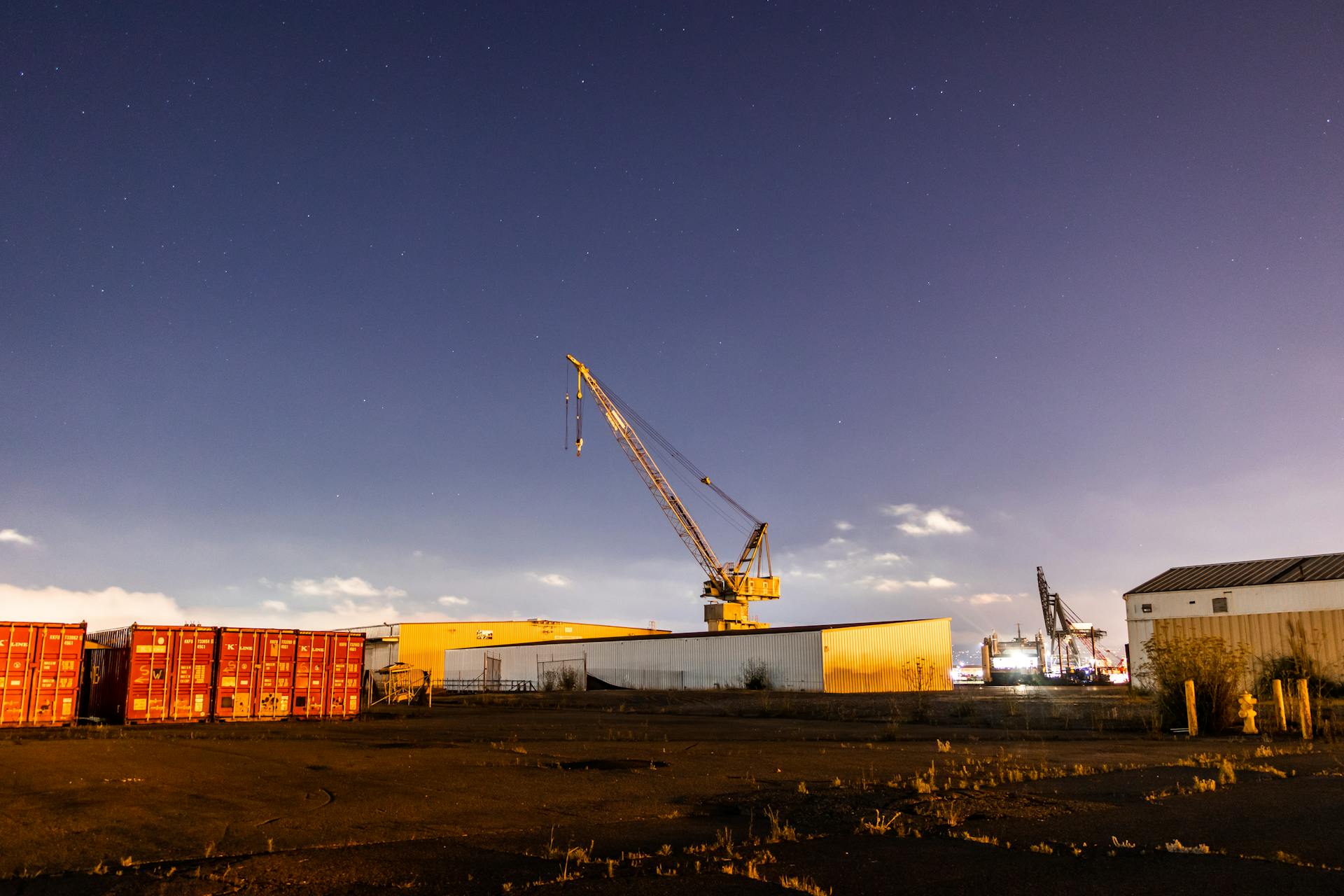
Intermediate bulk containers (IBCs) are incredibly versatile and can be used for a wide range of applications. From shipping hazardous materials to storing food ingredients, IBCs are a reliable and efficient solution.
Used IBCs can be repurposed as the basic building blocks for home aquaponic systems, making them a great option for DIY enthusiasts. They can also be used to store rainwater, providing a sustainable solution for water conservation.
IBCs are commonly used to transport and store petrochemical products, such as oil, gas, solvents, detergents, and adhesives. This makes them an essential tool for industries that rely on these products.
In the food industry, IBCs are used to store food syrups, such as corn syrup, maple syrup, or molasses. They're also used to store pharmaceutical compounds, ingredients, and intermediates.
IBCs are used in various industries, including agriculture, nursery, and greenhouse uses, as well as in water, waste water, and process water applications. This versatility makes them a valuable asset for businesses that need to store and transport a wide range of products.
Related reading: Smart Labels Food Packaging
Safety and Regulations

Safety and Regulations are crucial when it comes to Intermediate Bulk Containers.
Plastic IBCs containing combustible or flammable liquids can melt or burn rapidly, releasing their entire contents and increasing the fire hazard.
Rigid plastic IBCs that transport and house flammable/combustible materials are recommended to have clear labelling and be stored within properly secured structures and according to government regulations, such as NFPA and OSHA in the U.S.
Metal IBCs, as carbon steel and stainless steel, are often approved per UL 142 requirements for housing these materials long term.
Metal IBC tanks can be used for Class I materials, while rigid plastic IBCs can be used for Class II/III materials.
Research by the U.S.A. Department of Transportation indicates that IBC containers perform very well during transit in terms of sloshing and mechanical stability.
Metal IBCs, equipped with a pressure venting device, can withstand fire for at least 30 minutes, as shown by test reports from the German Bundesanstalt für Materialforschung und -prüfung (BAM).
Materials and Construction
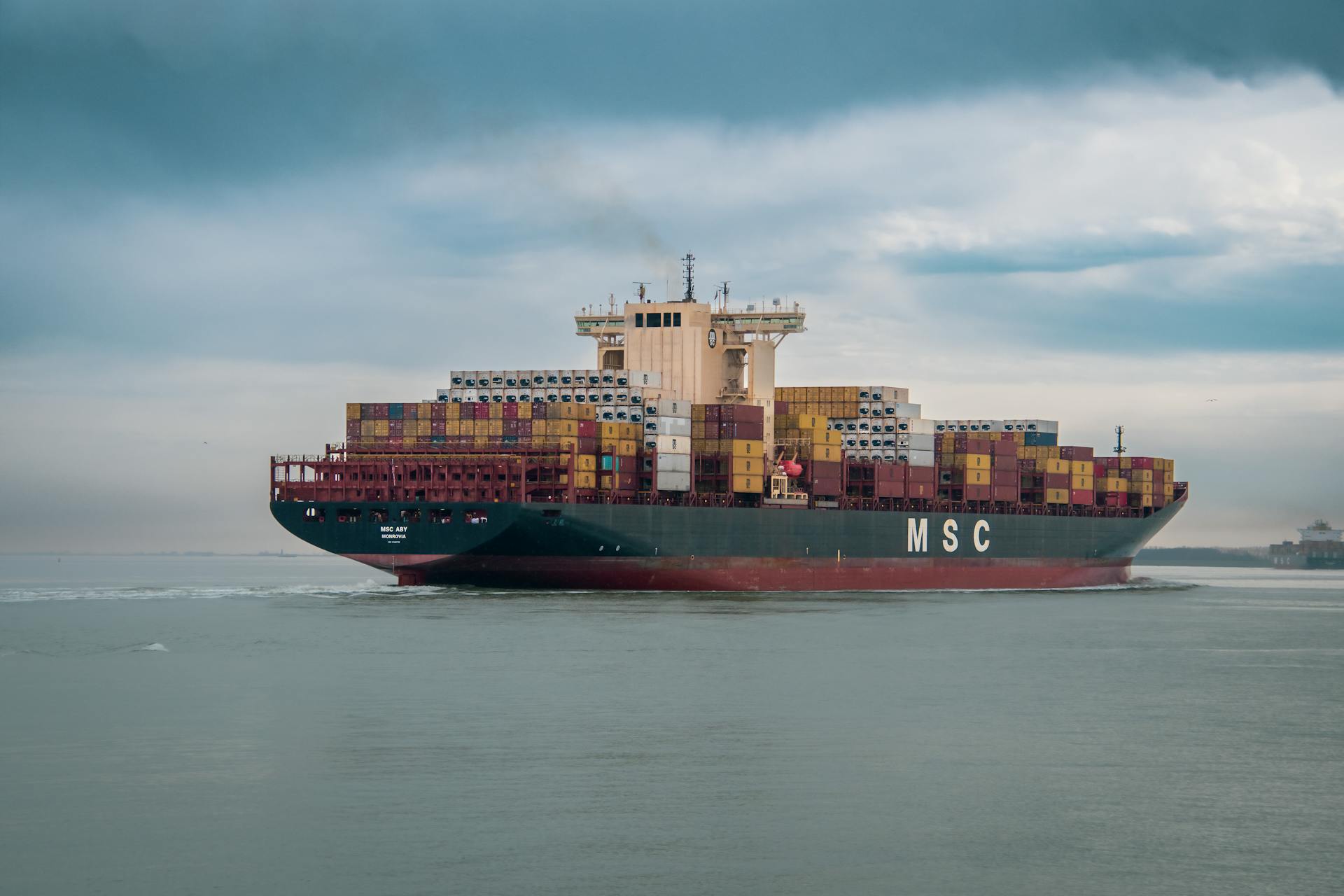
Intermediate bulk containers, or IBCs, are made from a variety of materials to suit different needs.
The inner containers of cube-shaped rigid IBCs are often made from plastic such as polyethylene or high-density polyethylene (HDPE).
TranPak's IBCs are made of HDPE, a durable and long-lasting material.
The rigid outer container or cage is usually made from galvanized tubular steel or iron.
Folding IBCs, on the other hand, are made of very durable plastic that folds inward when empty.
Stainless steel IBCs are designed to meet the highest hygiene and safety requirements, keeping the product free of contaminants.
Rigid
Rigid IBCs are a type of bulk box that can be reused and offer versatility with an integrated pallet base mount. This feature provides forklift and pallet jack maneuverability.
Rigid IBCs can be made from metal, plastic, or a composite construction of the two materials. They're manufactured across a volume range that's between standard shipping drums and intermodal tank containers.

Many rigid IBCs are designed to be stackable, which is a convenient feature for storing and transporting goods.
The standard tank capacities for IBCs are often 1,040 and 1,250 litres (275 and 330 US gal). This is a common size range for these containers.
Here are some common materials used to manufacture rigid IBCs:
- Plastic (high-density polyethylene)
- Composite: galvanized steel and plastic
- Carbon steel
- Stainless steel (304 and 316/316L grades)
These materials are chosen based on the requirements of the application or service the IBC will be used for.
Collapsible
Collapsible IBCs are a game-changer for industries where space is limited. They can be folded when not in use to save space.
These containers are designed to be stacked, making them easy to store. The replaceable plastic bags with a typical volume of 500 or 1000 litres make them easy to clean and reuse.
The collapsible IBCs are commonly used in industries like pharmaceuticals, cosmetics, and food. Several designs have been developed to meet the specific needs of these industries.
Flexible Big Bag

Flexible big bags are made of woven polyethylene or polypropylene or other heavy polymers.
They can hold a significant amount of weight, ranging from 500 to 1,000 kg.
Typically, they have a volume of 285–2,830 litres, which is equivalent to 10–100 cu ft.
Flexible big bags are designed for storing or transporting dry, flowable products, such as sand, fertilizer, and plastic granules.
They often have lifting straps for easy handling, but are frequently handled on a pallet instead.
Reusable and Recyclable
Reusable and recyclable IBCs are made from durable and recyclable materials, such as the Greif GCUBE, which has a long lifespan.
Using an IBC can reduce the need for single-use packaging and transportation, which can positively impact the environment. This is especially true for industries that require strict hygiene regulations, such as food, where the replaceable plastic bags with a typical volume of 500 or 1000 litres make cleaning and reuse easy.
In some cases, IBCs can be reused multiple times, making them a more sustainable option. The three broad types of IBCs in use today can be categorized under rigid, folding, and flexible, each with its own unique characteristics and uses.
IBC totes can be made in various volumes, including 275 gallons and 330 gallons, which are the two most common volumes of rigid IBCs. This allows customers to choose the right size for their specific needs.
What Are They Made Of?
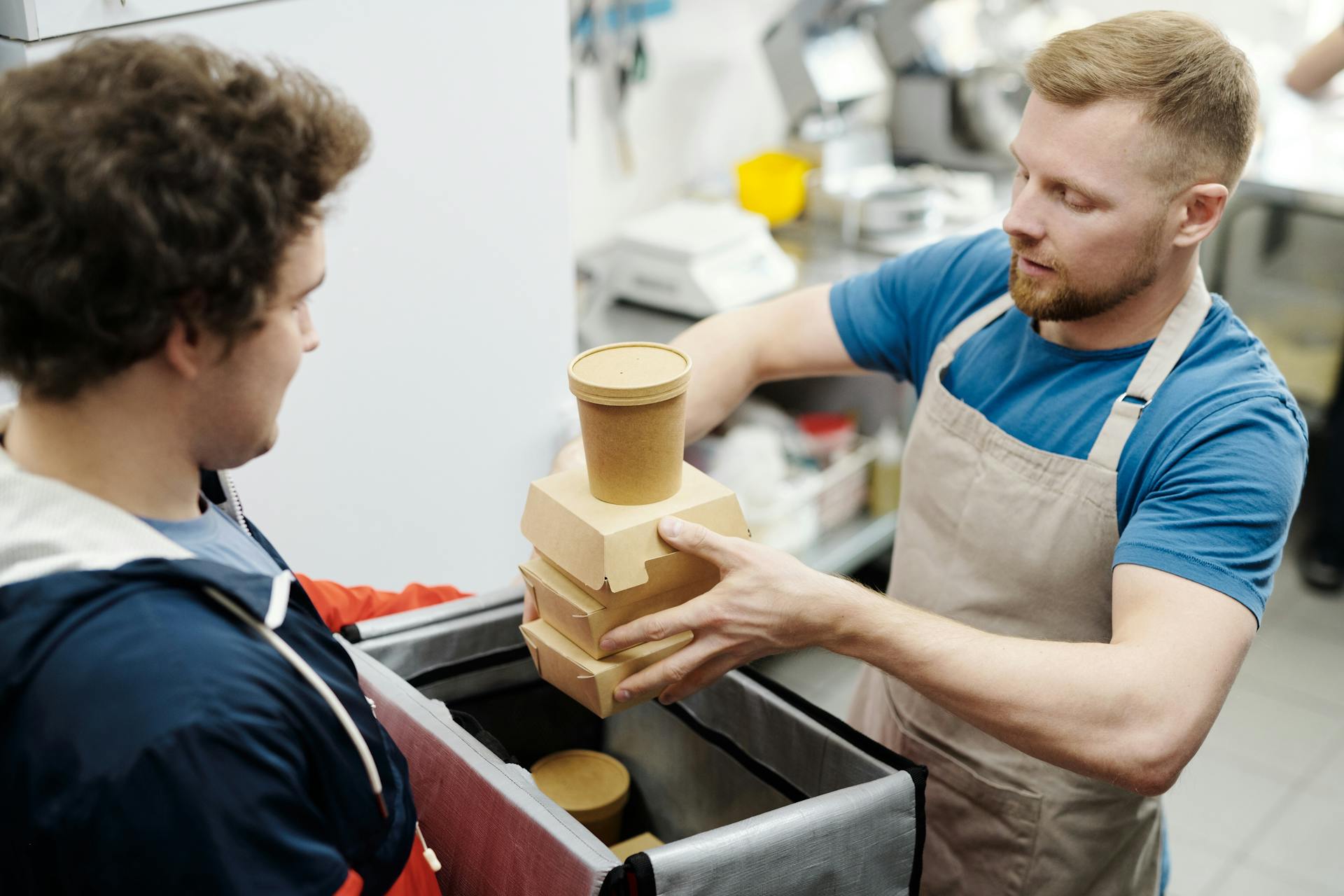
IBCs can be made from a variety of materials, including plastic, aluminum, and galvanized iron.
TranPak's IBCs are made of HDPE, a type of plastic.
The rigid outer container or cage is often made from galvanized tubular steel or iron.
Flexible IBCs or bulk bags are made from heavy duty materials such as woven polypropylene or polyethylene.
Stainless Steel
Stainless Steel is a popular material for IBCs, designed to meet the highest hygiene and safety requirements, keeping the product free of contaminants.
This means that stainless steel IBCs are perfect for industries that require a high level of cleanliness, such as food and beverage production.
Stainless steel IBCs are also durable and resistant to corrosion, making them a great choice for outdoor use.
Their ability to withstand harsh environments makes them ideal for use in a variety of settings.
Polyethylene containers
Polyethylene containers are a popular choice for IBCs due to their durability and versatility. They can hold anywhere from 285 to 2,830 litres of dry, flowable products like sand and fertilizer.
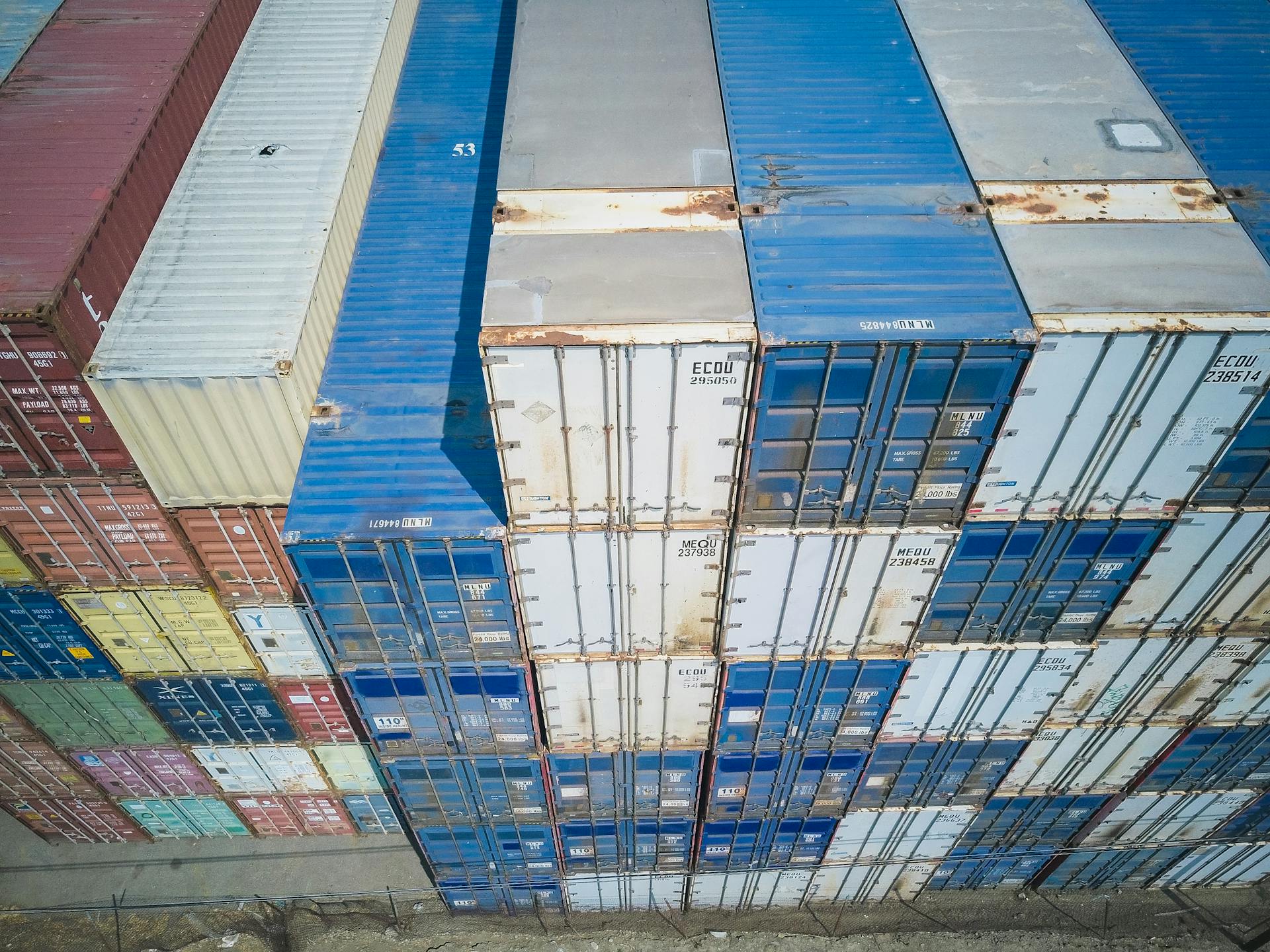
Flexible IBCs, which are made from polyethylene, can be used for storing and transporting products like plastic granules. They typically have lifting straps and are often handled on a pallet.
The inner containers of cube-shaped rigid IBCs can be made from polyethylene, which is a strong and lightweight material. This makes it ideal for containing products like dry goods and powders.
Flexible IBCs are made from heavy-duty materials like woven polypropylene or polyethylene, which can withstand heavy use and rough handling. They are also designed to be reusable and recyclable.
Industrial Containers
Industrial containers are designed for heavy-duty use and can be categorized into three broad types: rigid, folding, and flexible. These containers are made from durable materials and can withstand the rigors of frequent use.
The term "intermediate" in intermediate bulk container refers to the volume it carries, which sits between that of tanks and drums. The two most common volumes of the rigid IBC are 275 gallons and 330 gallons.
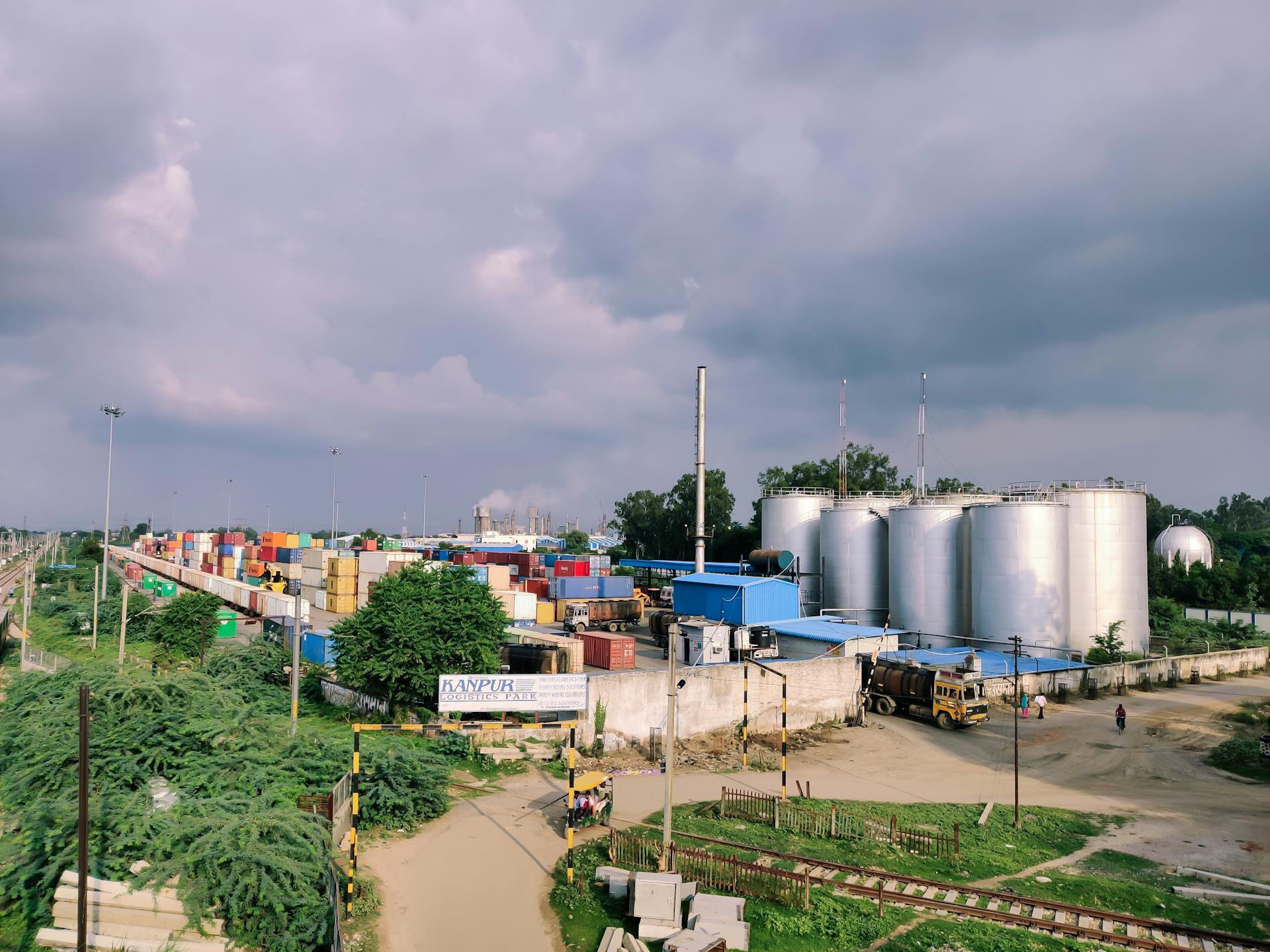
Industrial containers can be reused multiple times, making them a sustainable option for businesses. In fact, some IBCs can be cleaned and reused up to multiple times, reducing the need for single-use packaging and transportation.
Using an IBC can be a more environmentally friendly option than relying on single-use containers. This is especially true for companies that need to transport bulk liquids and powders on a regular basis.
About Greif Totes
Greif totes, also known as IBC totes, are highly efficient containers for storing and transporting bulk quantities of liquid and semi-liquid products.
Their design features a tubular, galvanized steel cage that provides superior strength and durability compared to other tube profiles on the market.
The cage is encased around an IBC tank, making it a rugged and reliable container for a variety of applications.
Greif's GCUBE IBC tote is a notable example of this design, offering a durable and efficient solution for businesses that need to store and transport bulk quantities of products.
The cage's square tube design is particularly effective at providing strength and durability, making it a great option for companies that require a lot of support for their IBC containers.
Why Customers Choose an IBC

Customers choose IBCs for their packaging needs because they are cost-effective, especially when shipping large quantities of product. This can lead to significant savings on the bottom line.
One of the main reasons IBCs are cost-effective is because they can be reused and reconditioned, driving further value. This can be a game-changer for businesses that need to move large amounts of product regularly.
IBCs can also be quickly loaded and unloaded, reducing handling times and increasing efficiencies in the supply chain. This is particularly useful in industries where speed and accuracy are crucial.
The IBC's design and structure can help reduce the risk of spills and other accidents during transportation, making it a safer option. This is especially important for businesses that need to transport hazardous materials.
Many IBCs are made with reusable materials, which can help reduce waste and improve the overall sustainability of the supply chain. This is a great option for businesses that want to reduce their environmental impact.
The Matcon Range
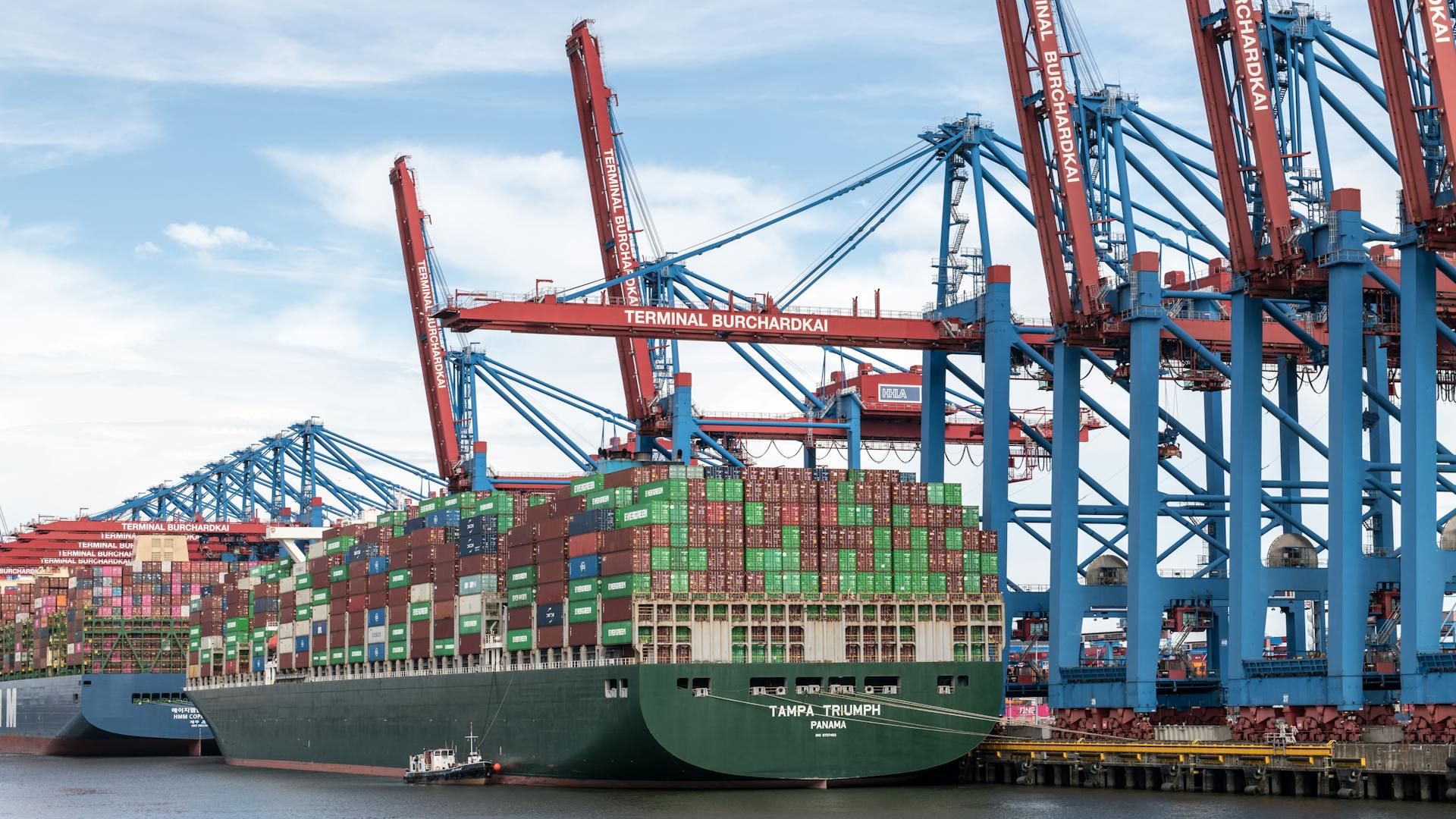
The Matcon Range is designed for high-speed and high-volume applications.
Matcon's bulk container range is available in various sizes, including 500, 1000, and 1500 liters.
These containers are ideal for high-speed applications, such as those found in the pharmaceutical and food industries.
The Matcon range features a unique aseptic design, which is essential for applications where product cleanliness is paramount.
Matcon's aseptic design minimizes the risk of contamination and ensures a clean and safe environment for filling and emptying the container.
You might enjoy: 40 High Cube Container
Clean
Cleanliness is a top priority when it comes to intermediate bulk containers, and for good reason. The design of IBCs is hygienic, making it easy to clean them quickly.
One of the benefits of this design is that it allows for off-line cleaning of IBCs, eliminating system downtime.
This means that you can clean the IBCs without interrupting production, which is a huge advantage in many industries.
Frequently Asked Questions
What are intermediate containers?
Intermediate containers, also known as IBCs, are reusable containers designed for transporting and storing liquids, semi-solids, and solids in industrial settings. They come in various materials, including metal, plastic, and composite.
What is the capacity of an intermediate bulk container?
Intermediate bulk containers typically come in capacities of 1,040 and 1,250 litres. These standardized containers are designed for safe transport of various commodities, including hazardous and non-hazardous materials.
Why are IBC totes so expensive?
IBC totes are made from high-quality, durable materials like stainless steel, carbon steel, and high-density polyethylene, which increases their cost. Despite the initial investment, IBC totes are built to last and can provide long-term cost savings through reduced maintenance and replacement needs.
Featured Images: pexels.com


